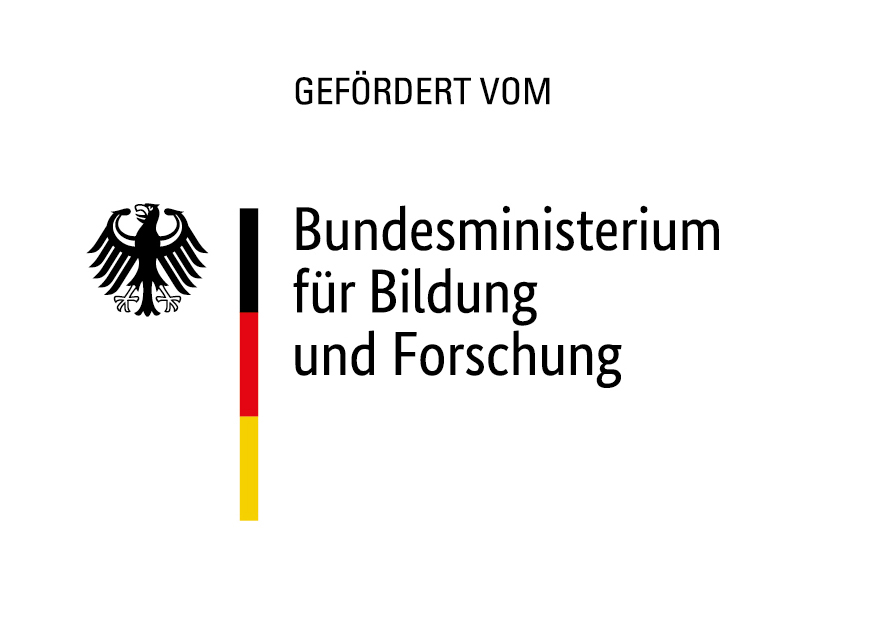Publications
Here you can find publications related to the funding measure here.
ClimFiSoc I Die Realpolitik der Klimafinanzierung
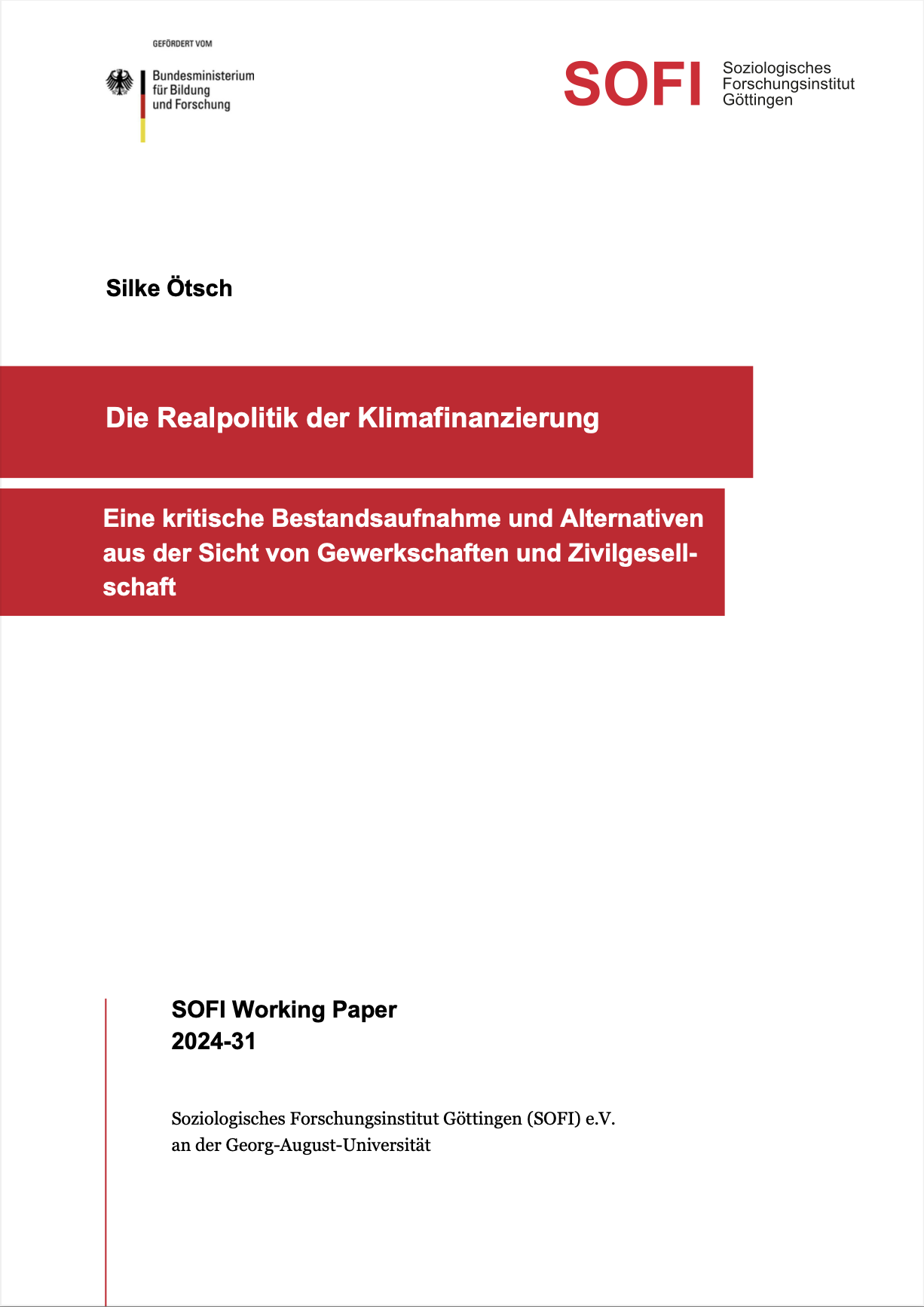
Die Realpolitik der Klimaschutzfinanzierung. Eine kritische Bestandsaufnahme und Alternativen aus der Sicht von Gewerkschaften und Zivilgesellschaft.
Der Beitrag beschäftigt sich mit derzeit verfolgten Politiken der Finanzierung von Klimaschutz und Anpassung an den Klimawandel und diskutiert Schwachstellen und Alternativen aus Perspektiven, die in diesem Bereich bislang unterrepräsentiert waren: aus der Sicht von Gewerkschaften, Umweltorganisationen und -bewegungen, des Globalen Südens und finanz- und wirtschaftskritischen Organisationen. Der Text gibt einen Überblick über die finanzielle und wirtschaftliche Dimension des Wandels. Er stellt die Klimafinanzierungspolitiken, insbesondere die Sustainable Finance-Initiative dar. Ein Zwischenfazit zeigt, dass die Politiken weniger erfolgreich sind als erhofft. Auf der Grundlage von 25 im Jahr 2023 geführten Interviews mit Expert:innen aus Gewerkschaften und Zivilgesellschaft werden Schwachpunkte und alternative Maßnahmen und Politiken aufgezeigt. Ich schließe, dass Politik und Finanzexpert:innen zu sehr auf wenig konfliktive freiwillige Verhaltensänderungen setzen und ökonomische, ökologische, soziale und demokratische Anliegen noch nicht ausreichend verbinden. Bislang ausgeklammerte Politiken und Instrumente im Bereich Ordnungspolitik, Geld- und Steuerpolitik sollten erwogen werden. Konflikte sollten nicht nur über Kommunikationsstrategien überdeckt, sondern in substanziellen Aushandlungsprozessen angegangen und ausgetragen werden.
- Veröffentlichungsdatum: 2024
- Autor:innen: Silke Ötsch
- Publikationsart: Working Paper
- Link zum PDF-Dokument
ClimLabels I Integrating “transition” more systematically into finance
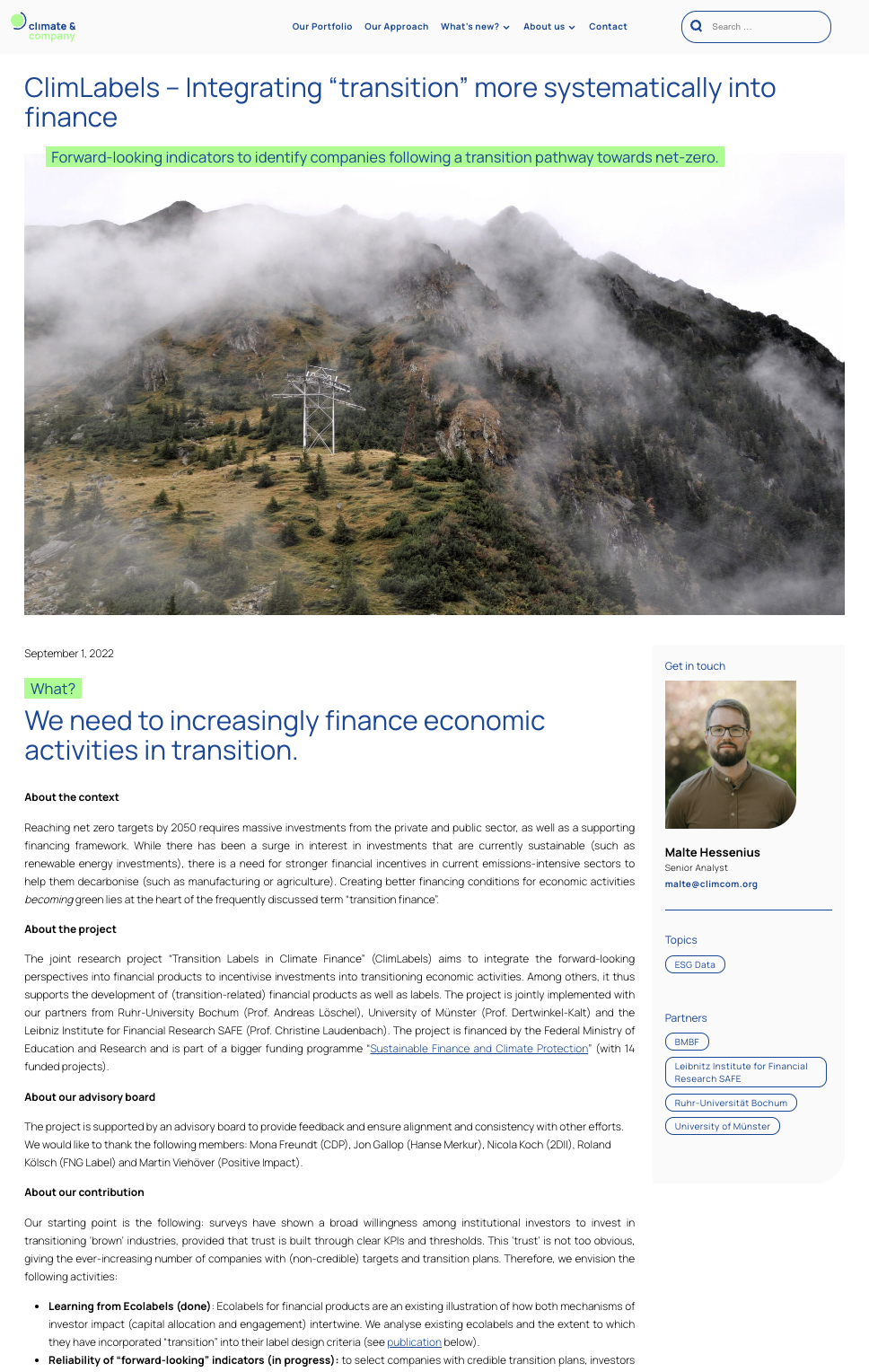
ClimLabels - Integrating “transition” more systematically into finance Forward-looking indicators to identify companies following a transition pathway towards net-zero.
About the context: Reaching net zero targets by 2050 requires massive investments from the private and public sector, as well as a supporting financing framework. While there has been a surge in interest in investments that are currently sustainable (such as renewable energy investments), there is a need for stronger financial incentives in current emissions-intensive sectors to help them decarbonise (such as manufacturing or agriculture). Creating better financing conditions for economic activities becoming green lies at the heart of the frequently discussed term “transition finance”. About the project: The joint research project “Transition Labels in Climate Finance” (ClimLabels) aims to integrate the forward-looking perspectives into financial products to incentivise investments into transitioning economic activities. Among others, it thus supports the development of (transition-related) financial products as well as labels. The project is jointly implemented with our partners from Ruhr-University Bochum (Prof. Andreas Löschel), University of Münster (Prof. Dertwinkel-Kalt) and the Leibniz Institute for Financial Research SAFE (Prof. Christine Laudenbach). The project is financed by the Federal Ministry of Education and Research and is part of a bigger funding programme “Sustainable Finance and Climate Protection” (with 14 funded projects).
- Veröffentlichungsdatum: 01.09.2022
- Autor:innen: Malte Hessenius
- Publikationsart: Website-Beitrag
- Link zum Beitrag
ClimLabels I Investor Impact in Transition Finance: Learning from Ecolabels
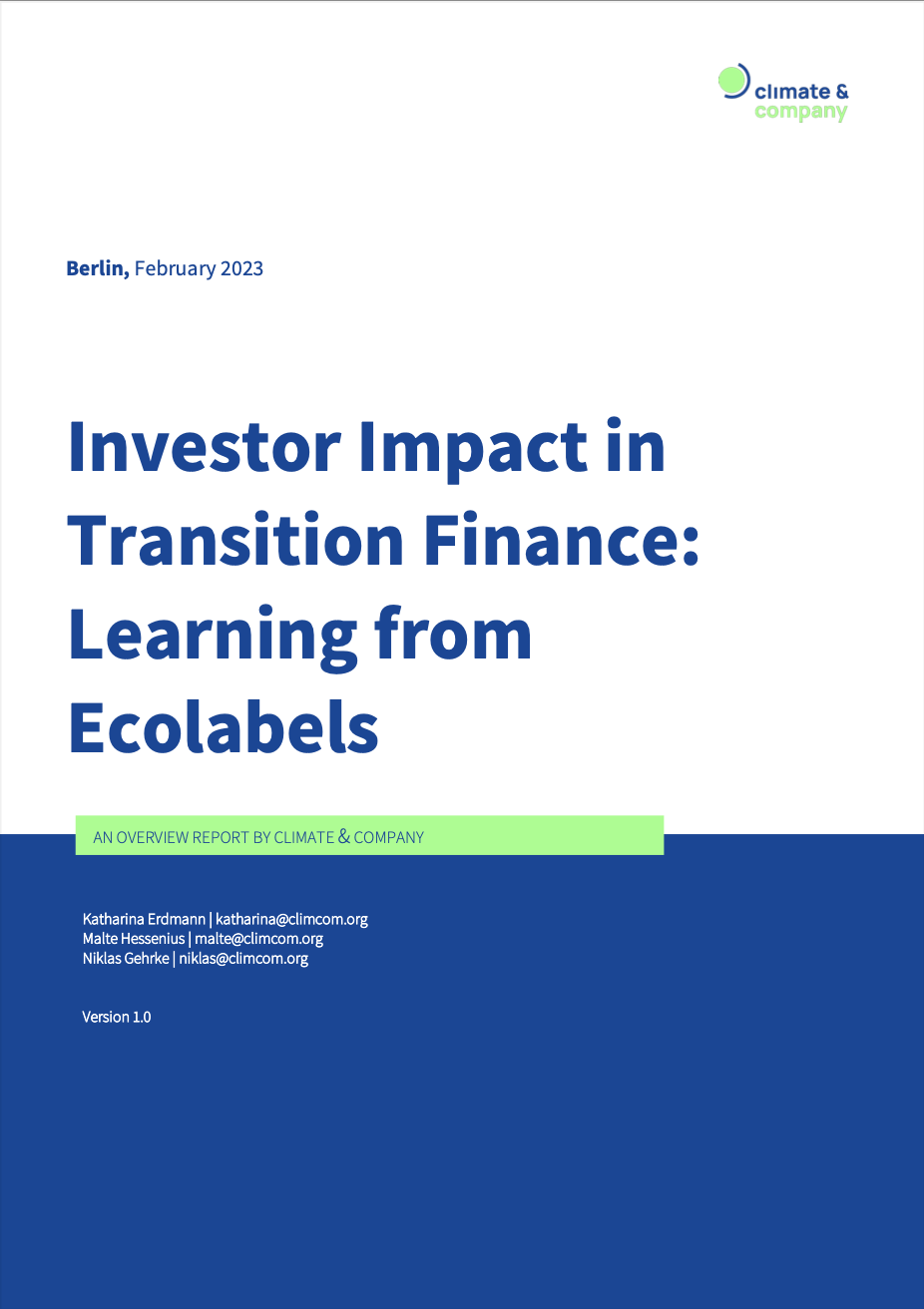
Investor Impact in Transition Finance: Learning from Ecolabels
This publication is a first overview paper, originating from our ClimLabels project. This paper sheds light on the evolving transition finance landscape with a particular focus on Ecolabels and what we can learn from them to construct transition finance products. This paper builds partially on our input on the UK’s proposed transition label.
- Veröffentlichungsdatum: 21.02.2023
- Autor:innen: Katharina Erdmann, Malte Hessenius & Niklas Gehrke
- Publikationsart: Overview Report
- Link zum PDF-Dokument
ClimLabels I Remarks on UK’s proposed transition investment label
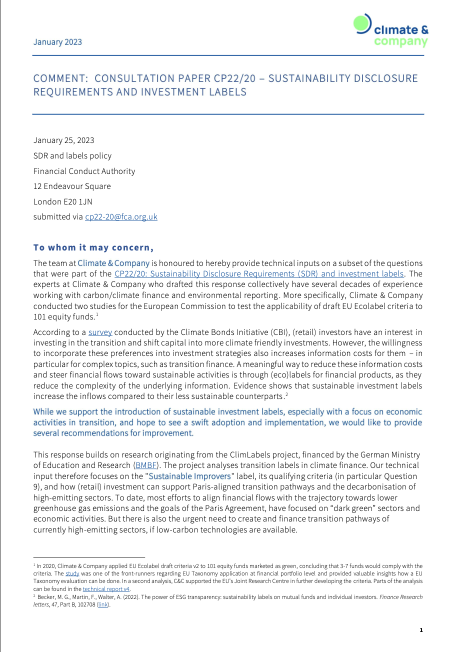
Remarks on UK’s proposed transition investment label
The UK Financial Conduct Authority (FCA) has proposed three sustainable investment labels (i.e., sustainable focus, sustainable improvers, sustainable impact) in the form of a consultation paper (link). Our response to the consultation builds on research originating from our ClimLabels project, financed by the German Ministry of Education and Research (BMBF). The project analyses transition labels in climate finance. Our technical input therefore focuses on the “Sustainable Improvers” label, its qualifying criteria (in particular Question 9), and how (retail) investment can support Paris-aligned transition pathways and the decarbonisation of high-emitting sectors. To date, most efforts to align financial flows with the trajectory towards lower greenhouse gas emissions and the goals of the Paris Agreement, have focused on “dark green” sectors and economic activities. But there is also the urgent need to create and finance transition pathways of currently high-emitting sectors, if low-carbon technologies are available. Our main recommendations to improve the “Sustainable Improvers” label are the following: A clear reference to the Paris Agreement and the UK climate/ environmental targets creates the necessary ambition and prevents greenwashing. A reduction of the investable universe by excluding high-impact companies without transition plans increases the credibility of the label. Specific requirements for the engagement process for the manager of the fund improves the success rate of the stewardship process.
- Veröffentlichungsdatum: 26.01.2023
- Autor:innen: Katharina Erdmann
- Publikationsart: Paper
- Link zum PDF-Dokument
CONFILIENCE I How to provide actionable information on weather and climate impacts? A summary of strategic, methodological, and technical perspectives
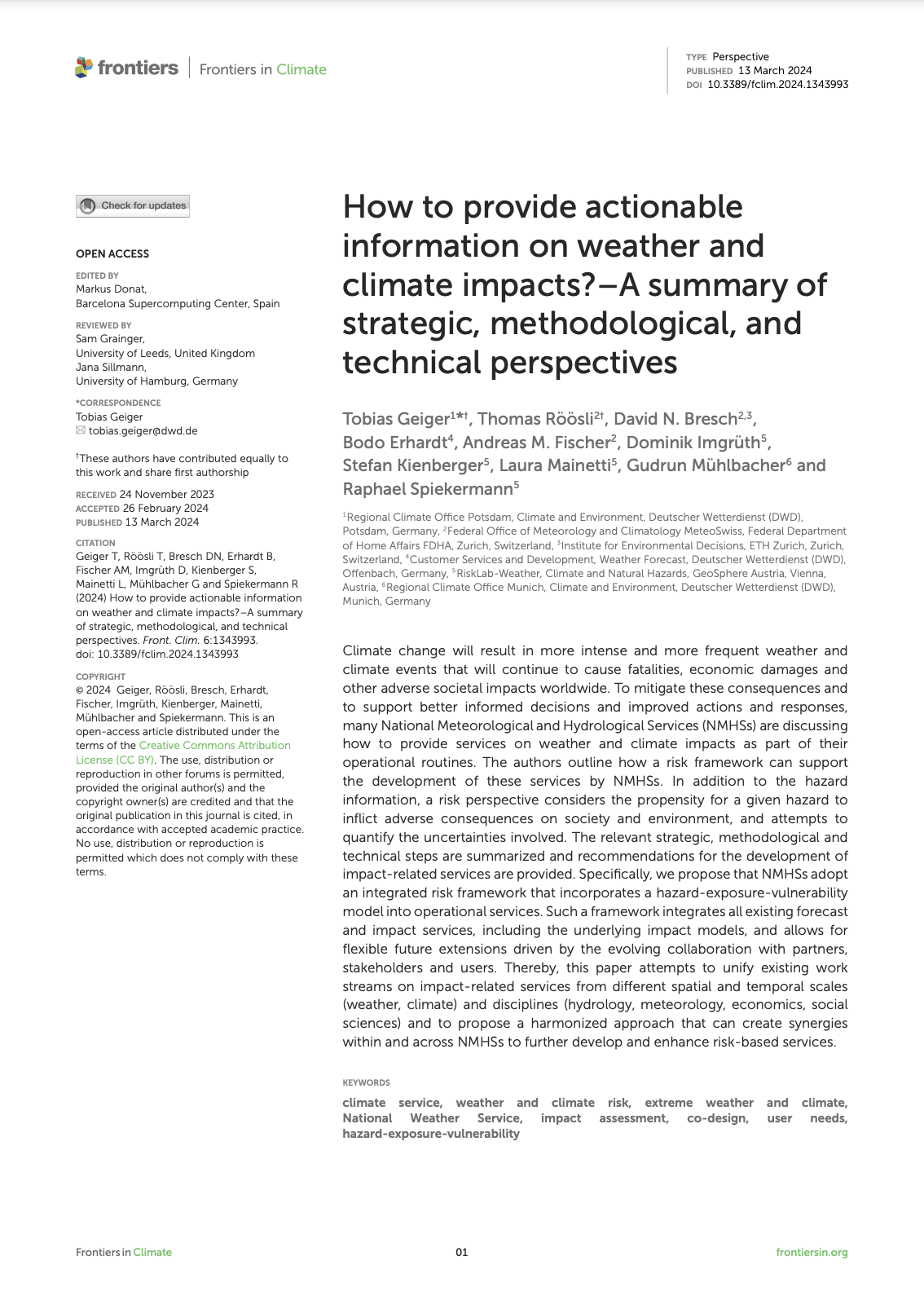
How to provide actionable information on weather and climate impacts? A summary of strategic, methodological, and technical perspectives
Climate change will result in more intense and more frequent weather and climate events that will continue to cause fatalities, economic damages and other adverse societal impacts worldwide. To mitigate these consequences and to support better informed decisions and improved actions and responses, many National Meteorological and Hydrological Services (NMHSs) are discussing how to provide services on weather and climate impacts as part of their operational routines. The authors outline how a risk framework can support the development of these services by NMHSs. In addition to the hazard information, a risk perspective considers the propensity for a given hazard to inflict adverse consequences on society and environment, and attempts to quantify the uncertainties involved. The relevant strategic, methodological and technical steps are summarized and recommendations for the development of impact-related services are provided. Specifically, we propose that NMHSs adopt an integrated risk framework that incorporates a hazard-exposure-vulnerability model into operational services. Such a framework integrates all existing forecast and impact services, including the underlying impact models, and allows for flexible future extensions driven by the evolving collaboration with partners, stakeholders and users. Thereby, this paper attempts to unify existing work streams on impact-related services from different spatial and temporal scales (weather, climate) and disciplines (hydrology, meteorology, economics, social sciences) and to propose a harmonized approach that can create synergies within and across NMHSs to further develop and enhance risk-based services.
- Veröffentlichungsdatum: 23.03.2024
- Autor:innen: Tobias Geiger, Thomas Röösli, David N. Bresch, Bodo Erhardt, Andreas M. Fischer, Dominik Imgrüth, Stefan Kienberger, Laura Mainetti, Gudrun Mühlbacher & Raphael Spiekermann
- Publikationsart: Paper
- Link zum PDF-Dokument
- Keywords: climate service, weather and climate risk, extreme weather and climate, National Weather Service, impact assessment, co-design, user needs, hazard-exposure-vulnerability
GAS I How to Green the European Auto ABS Market - A Literature Survey
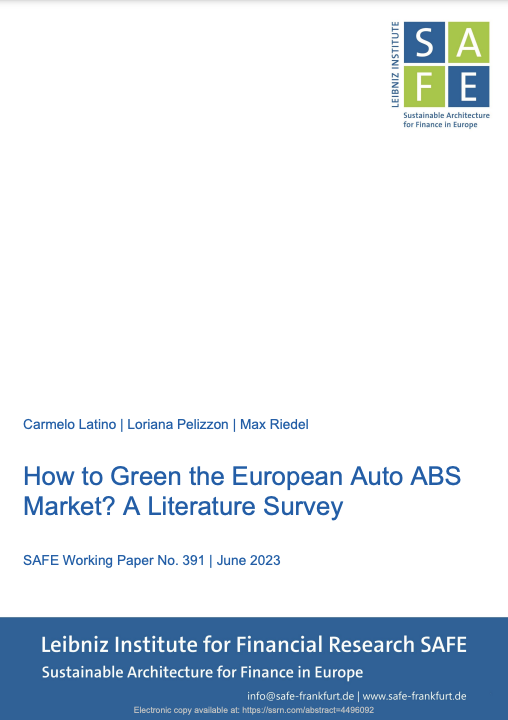
How to Green the European Auto ABS Market? A Literature Survey
This literature survey explores the potential avenues for the design of a green auto asset-backed security by focusing on the European auto securitization market. In this context, we examine the entire value chain of the securitization process to understand the incentives and interests involved at various stages of the transaction. We review recent regulatory developments, feasibility concerns, and potential designs of a sustainable securitization framework. Our study suggests that a Green Auto ABS should be based on both a green use of proceeds and a green collateral-based methodology.
- Veröffentlichungsdatum: 06.07.2023
- Autor:innen: Carmelo Latino, Loriana Pelizzon & Max Riedel
- Publikationsart: Working Paper
- Link zum PDF-Dokument
GAS I Vehicle identifiers: the key to jumpstarting the European Green Auto ABS market?
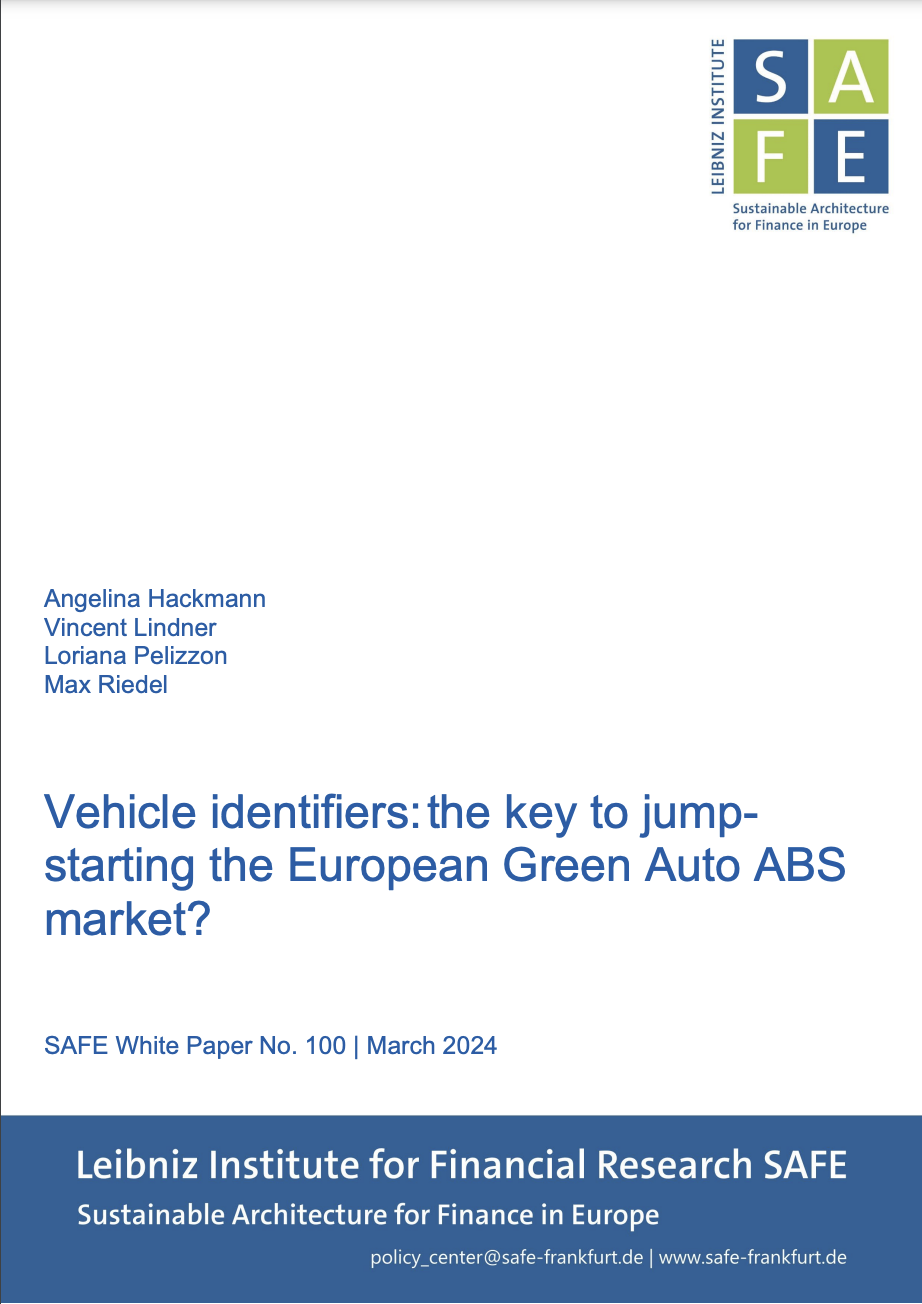
Vehicle identifiers: the key to jumpstarting the European Green Auto ABS market?
This paper addresses the need for transparent sustainability disclosure in the European Auto Asset-Backed Securities (ABS) market, a crucial element in achieving the EU's climate goals. It proposes the use of existing vehicle identifiers, the Type Approval Number (TAN) and the Type-Variant-Version Code (TVV), to integrate loan-level data with sustainability-related vehicle information from ancillary sources. While acknowledging certain challenges, the combined use of TAN and TVV is the optimal solution to allow all stakeholders to comprehensively assess the environmental characteristics of securitised exposure pools in terms of data protection, matching accuracy, and cost-effectiveness.
- Veröffentlichungsdatum: März 2024
- Autor:innen: Angelina Hackmann, Vincent Lindner, Loriana Pelizzon & Max Riedel
- Publikationsart: White Paper
- Link zum PDF-Dokument
INTERACT I Does the European Union need another Green Bond Standard?
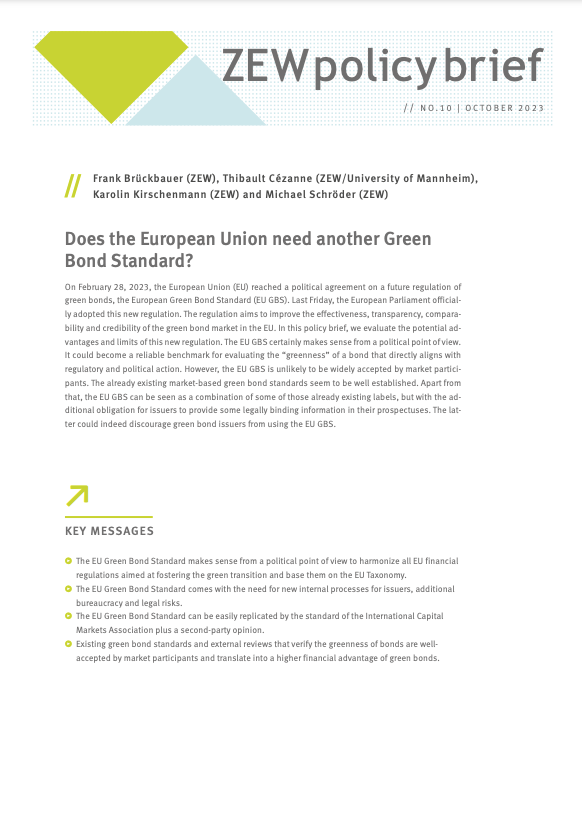
Does the European Union need another Green Bond Standard?
On February 28, 2023, the European Union (EU) reached a political agreement on a future regulation of green bonds, the European Green Bond Standard (EU GBS). Last Friday, the European Parliament officially adopted this new regulation. The regulation aims to improve the effectiveness, transparency, comparability and credibility of the green bond market in the EU. In this policy brief, we evaluate the potential advantages and limits of this new regulation. The EU GBS certainly makes sense from a political point of view. It could become a reliable benchmark for evaluating the “greenness” of a bond that directly aligns with regulatory and political action. However, the EU GBS is unlikely to be widely accepted by market participants. The already existing market-based green bond standards seem to be well established. Apart from that, the EU GBS can be seen as a combination of some of those already existing labels, but with the additional obligation for issuers to provide some legally binding information in their prospectuses. The latter could indeed discourage green bond issuers from using the EU GBS.
- Veröffentlichungsdatum: Oktober 2023
- Autor:innen: Frank Brückbauer, Thibault Cézanne, Karolin Kirschenmann & Michael Schröder
- Publikationsart: Policy Brief
- Link zum PDF-Dokument
INTERACT I The EU Taxonomy’s (Potential) Effects on the Banking Sector and Bank Lending to Firms
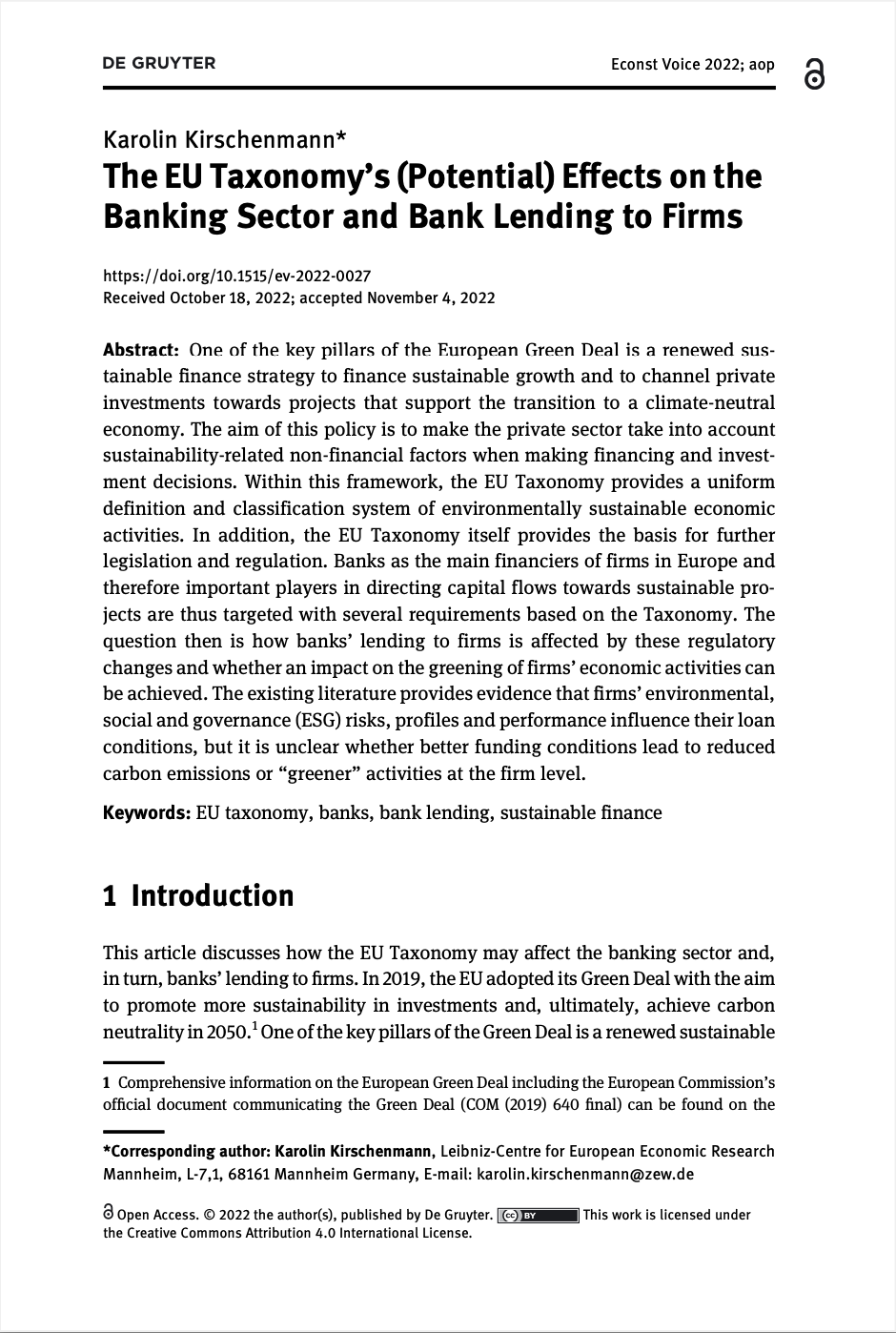
The EU Taxonomy’s (Potential) Effects on the Banking Sector and Bank Lending to Firms
One of the key pillars of the European Green Deal is a renewed sustainable finance strategy to finance sustainable growth and to channel private investments towards projects that support the transition to a climate-neutral economy. The aim of this policy is to make the private sector take into account sustainability-related non-financial factors when making financing and investment decisions. Within this framework, the EU Taxonomy provides a uniform definition and classification system of environmentally sustainable economic activities. In addition, the EU Taxonomy itself provides the basis for further legislation and regulation. Banks as the main financiers of firms in Europe and therefore important players in directing capital flows towards sustainable projects are thus targeted with several requirements based on the Taxonomy. The question then is how banks’ lending to firms is affected by these regulatory changes and whether an impact on the greening of firms’ economic activities can be achieved. The existing literature provides evidence that firms’ environmental, social and governance (ESG) risks, profiles and performance influence their loan conditions, but it is unclear whether better funding conditions lead to reduced carbon emissions or “greener” activities at the firm level.
- Veröffentlichungsdatum: 04.11.2022
- Autor:innen: Karolin Kirschenmann
- Publikationsart: Paper
- Link zum PDF-Dokument
KlimKomInvest I Sustainable Finance für Kommunen
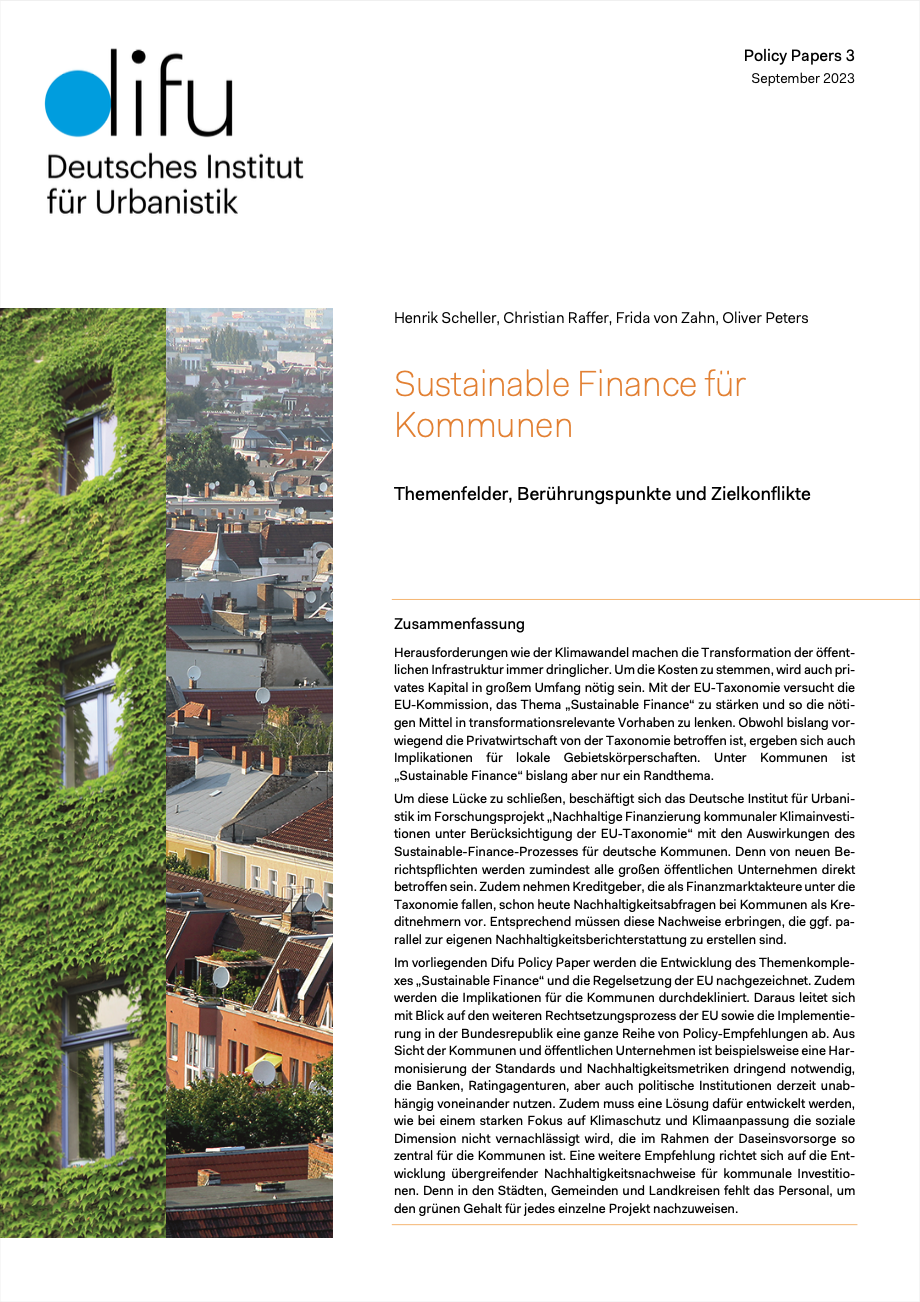
Sustainable Finance für Kommunen - Themenfelder, Berührungspunkte und Zielkonflikte
Herausforderungen wie der Klimawandel machen die Transformation der öffentlichen Infrastruktur immer dringlicher. Um die Kosten zu stemmen, wird auch privates Kapital in großem Umfang nötig sein. Mit der EU-Taxonomie versucht die EU-Kommission, das Thema „Sustainable Finance“ zu stärken und so die nötigen Mittel in transformationsrelevante Vorhaben zu lenken. Obwohl bislang vorwiegend die Privatwirtschaft von der Taxonomie betroffen ist, ergeben sich auch Implikationen für lokale Gebietskörperschaften. Unter Kommunen ist „Sustainable Finance“ bislang aber nur ein Randthema. Um diese Lücke zu schließen, beschäftigt sich das Deutsche Institut für Urbanistik im Forschungsprojekt „Nachhaltige Finanzierung kommunaler Klimainvestitionen unter Berücksichtigung der EU-Taxonomie“ mit den Auswirkungen des Sustainable-Finance-Prozesses für deutsche Kommunen. Denn von neuen Berichtspflichten werden zumindest alle großen öffentlichen Unternehmen direkt betroffen sein. Zudem nehmen Kreditgeber, die als Finanzmarktakteure unter die Taxonomie fallen, schon heute Nachhaltigkeitsabfragen bei Kommunen als Kreditnehmern vor. Entsprechend müssen diese Nachweise erbringen, die ggf. parallel zur eigenen Nachhaltigkeitsberichterstattung zu erstellen sind. Im vorliegenden Difu Policy Paper werden die Entwicklung des Themenkomplexes „Sustainable Finance“ und die Regelsetzung der EU nachgezeichnet. Zudem werden die Implikationen für die Kommunen durchdekliniert. Daraus leitet sich mit Blick auf den weiteren Rechtsetzungsprozess der EU sowie die Implementierung in der Bundesrepublik eine ganze Reihe von Policy-Empfehlungen ab. Aus Sicht der Kommunen und öffentlichen Unternehmen ist beispielsweise eine Harmonisierung der Standards und Nachhaltigkeitsmetriken dringend notwendig, die Banken, Ratingagenturen, aber auch politische Institutionen derzeit unabhängig voneinander nutzen. Zudem muss eine Lösung dafür entwickelt werden, wie bei einem starken Fokus auf Klimaschutz und Klimaanpassung die soziale Dimension nicht vernachlässigt wird, die im Rahmen der Daseinsvorsorge so zentral für die Kommunen ist. Eine weitere Empfehlung richtet sich auf die Entwicklung übergreifender Nachhaltigkeitsnachweise für kommunale Investitionen. Denn in den Städten, Gemeinden und Landkreisen fehlt das Personal, um den grünen Gehalt für jedes einzelne Projekt nachzuweisen.
- Veröffentlichungsdatum: September 2023
- Autor:innen: Henrik Scheller, Christian Raffer, Frida von Zahn & Oliver Peters
- Publikationsart: Policy Paper
- Link zum PDF-Dokument
KlimKomInvest I Sustainable Finance und die öffentliche Finanz- und Haushaltswirtschaft der Kommunen
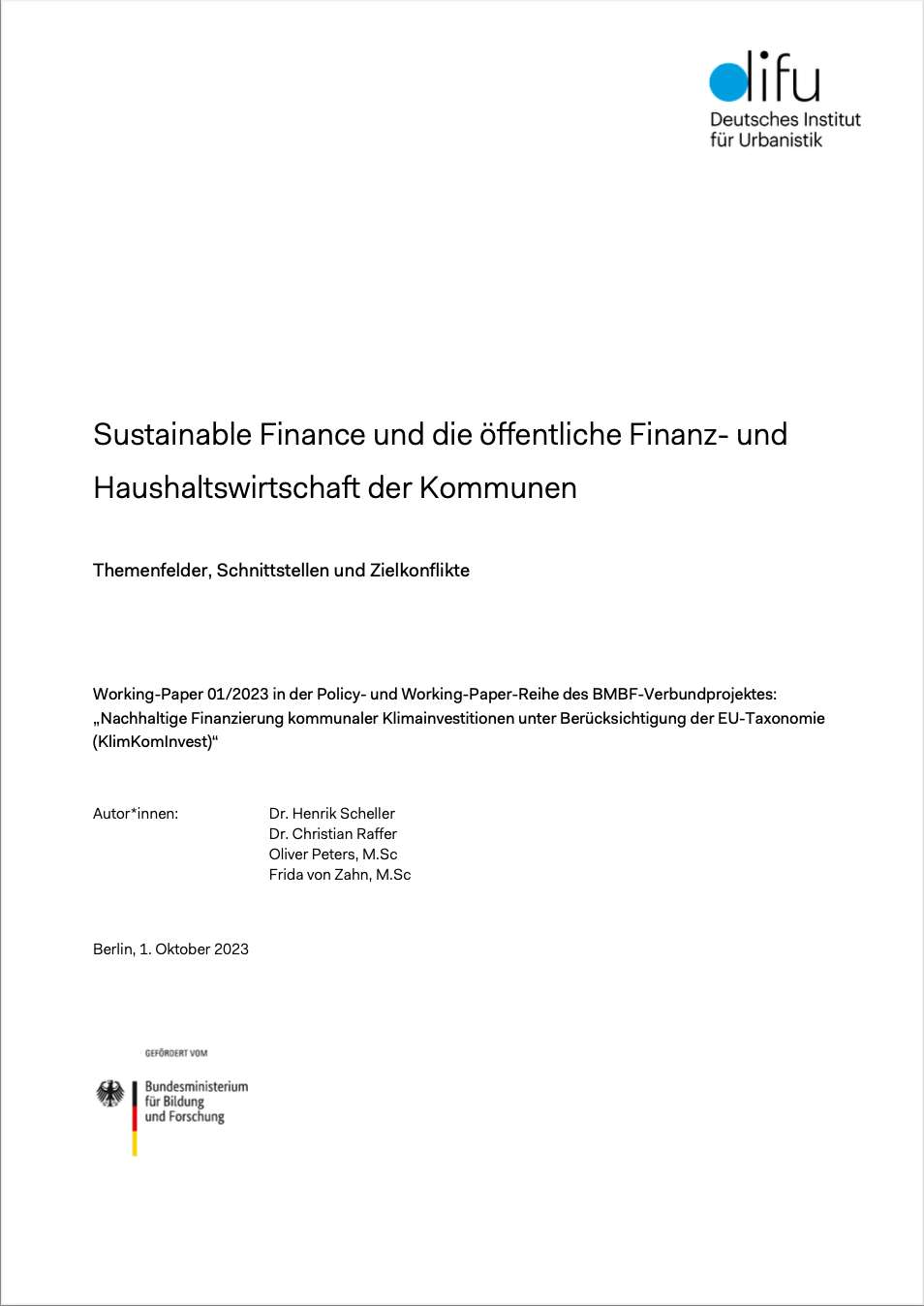
Sustainable Finance und die öffentliche Finanz- und Haushaltswirtschaft der Kommunen
Herausforderungen wie der Klimawandel machen die Transformation der öffentlichen Infrastruktur immer dringlicher. Um diese Kosten zu stemmen, wird auch privates Kapital in großem Umfang nötig sein. Mit der EU-Taxonomie versucht die EU-Kommission, das Thema „Sustainable Finance“ zu stärken und so die nötigen Mittel in transformationsrelevante Vorhaben zu lenken. Obwohl bislang vorwiegend die Privatwirtschaft von der Taxonomie betroffen ist, ergeben sich auch Implikationen für locale Gebietskörperschaften. Unter Kommunen ist „Sustainable Finance“ bislang aber nur ein Randthema. Um diese Lücke zu schließen, beschäftigt sich das Deutsche Institut für Urbanistik im Forschungsprojekt „Nachhaltige Finanzierung kommunaler Klimainvestitionen unter Berücksichtigung der EU-Taxonomie“ mit den möglichen Auswirkungen des Sustainable-Finance-Prozesses für deutsche Kommunen. Denn von neuen Berichtspflichten werden zumindest alle großen öffentlichen Unternehmen direct betroffen sein. Zudem nehmen Kreditgeber, die als Finanzmarktakteure unter die Taxonomie fallen, schon heute Nachhaltigkeitsabfragen bei Kommunen als Kreditnehmern vor. Entsprechend müssen diese Nachweise erbringen, die ggf. parallel zur eigenen Nachhaltigkeitsberichterstattung zu erstellen sind. Im vorliegenden Difu-Policy-Paper werden die Entwicklung des Themenkomplexes „Sustainable Finance“ und die Regelsetzung der EU nachgezeichnet. Zudem werden die Implikationen für die Kommunen durchdekliniert. Daraus werden mit Blick auf den weiteren Rechtsetzungsprozess der EU sowie die Implementierung in der Bundesrepublik folgende Policy-Empfehlungen abgeleitet.
- Veröffentlichungsdatum: 01.10.2023
- Autor:innen: Henrik Scheller, Christian Raffer, Oliver Peters & Frida von Zahn
- Publikationsart: Working Paper
- Link zum PDF-Dokument
SATISFY I Are sustainability-linked loans designed to effectively incentivize corporate sustainability? A framework for review
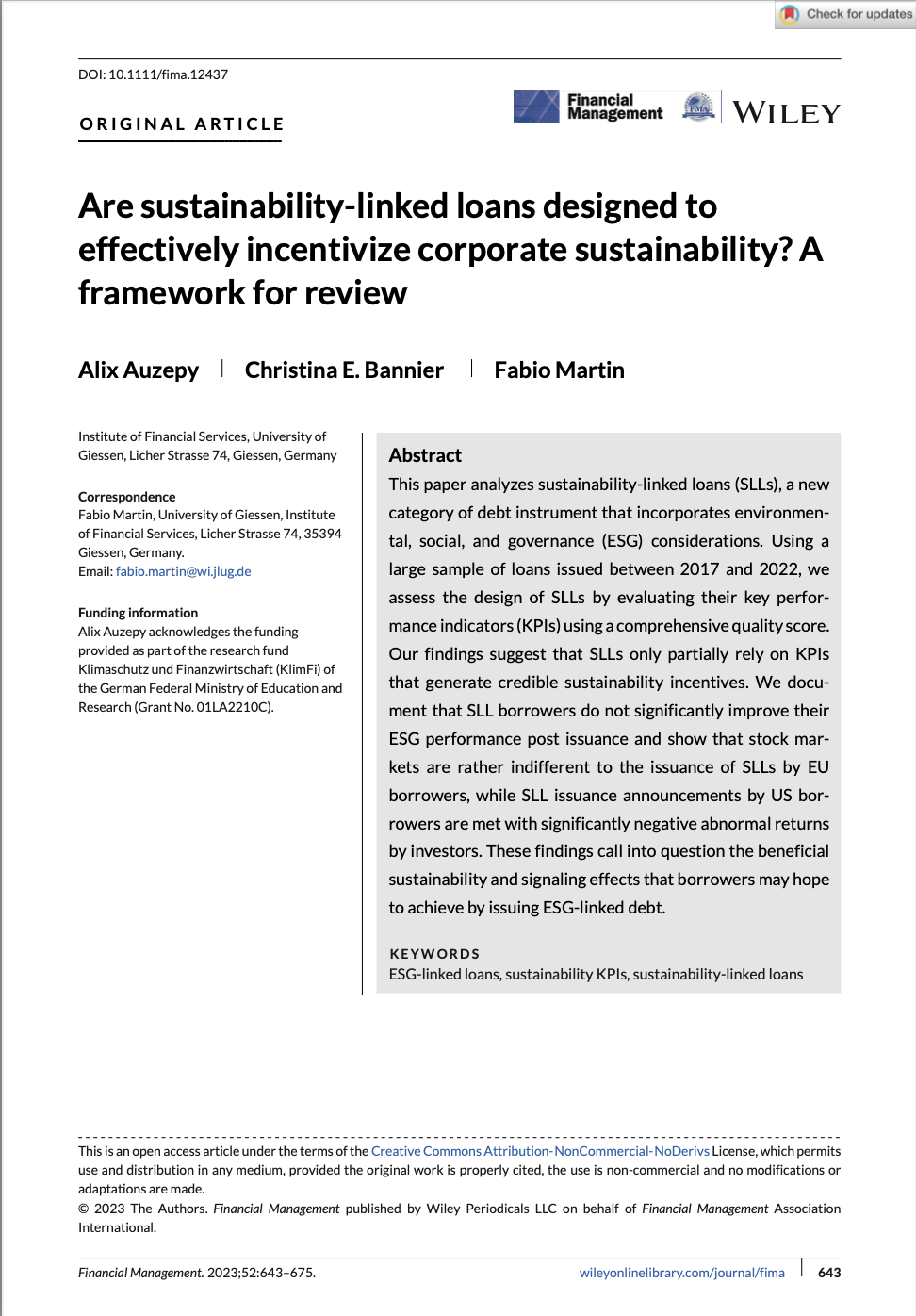
Are sustainability-linked loans designed to effectively incentivize corporate sustainability? A framework for review
This paper analyzes sustainability-linked loans (SLLs), a new category of debt instrument that incorporates environmen- tal, social, and governance (ESG) considerations. Using a large sample of loans issued between 2017 and 2022, we assess the design of SLLs by evaluating their key perfor- mance indicators (KPIs) using a comprehensive quality score. Our findings suggest that SLLs only partially rely on KPIs that generate credible sustainability incentives. We docu- ment that SLL borrowers do not significantly improve their ESG performance post issuance and show that stock mar- kets are rather indifferent to the issuance of SLLs by EU borrowers, while SLL issuance announcements by US bor- rowers are met with significantly negative abnormal returns by investors. These findings call into question the beneficial sustainability and signaling effects that borrowers may hope to achieve by issuing ESG-linked debt.
- Veröffentlichungsdatum: 03.10.2023
- Autor:innen: Alix Auzepy, Christina E. Bannier & Fabio Martin
- Publikationsart: Article
- Link zum PDF-Dokument
SATISFY I Climate scenarios in banks – a case study
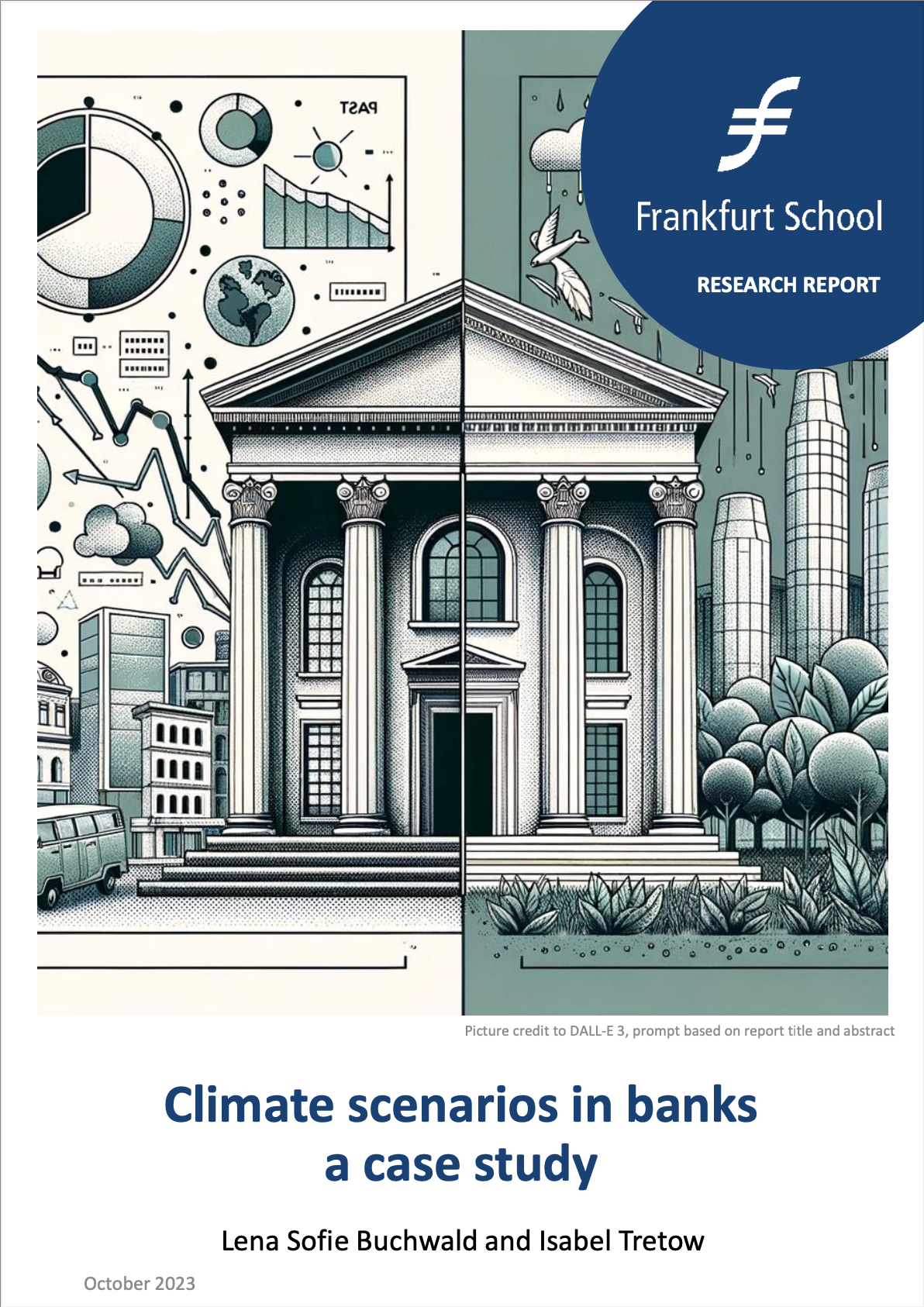
Climate scenarios in banks – a case study
In this report, we develop and apply a typology that helps banks differentiate climate scenarios based on their characteristics and discuss four use cases. With the increasing importance of climate scenarios for assessing the risks and opportunities of climate change in the financial system, banks face the question of which climate scenarios to select for different use cases. We review academic and grey literature to develop a typology that helps banks differentiate climate scenarios using a heuristics approach. We differentiate commonly used scenarios based on the typology. We then apply the typology through a case study in a large German promotional bank. Being the first case study with a bank in this field, the paper adds to the literature by providing a characterisation of climate scenarios for banks and by supporting the selection of a climate scenario amongst banks.
- Veröffentlichungsdatum: 20.10.2023
- Autor:innen: Lena Sofie Buchwald & Isabel Tretow
- Publikationsart: Research Report
- Link zum PDF-Dokument
SATISFY I European corporate sustainability reporting - The Financial Materiality Compass as an auxiliary tool
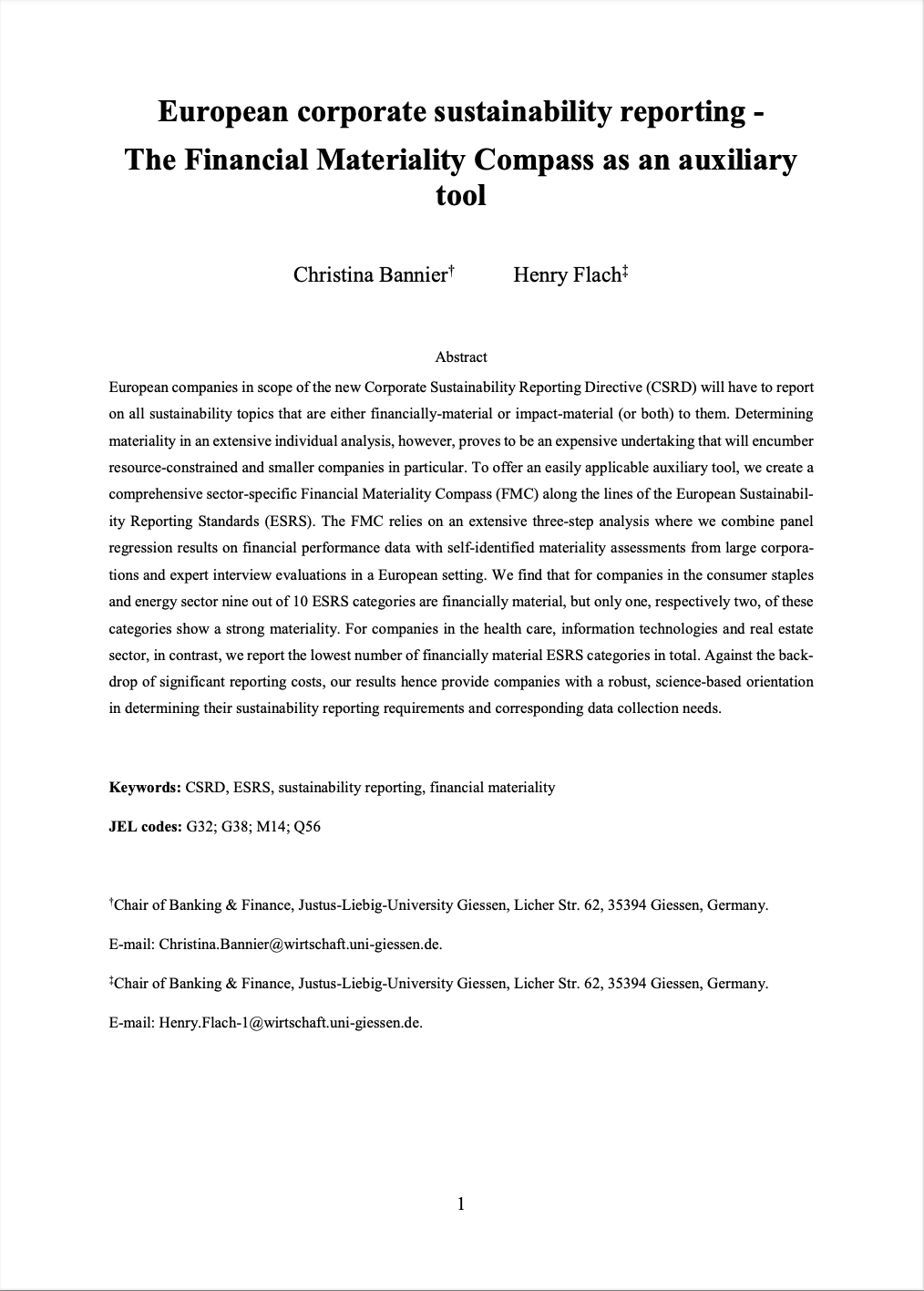
European corporate sustainability reporting - The Financial Materiality Compass as an auxiliary tool
European companies in scope of the new Corporate Sustainability Reporting Directive (CSRD) will have to report on all sustainability topics that are either financially-material or impact-material (or both) to them. Determining materiality in an extensive individual analysis, however, proves to be an expensive undertaking that will encumber resource-constrained and smaller companies in particular. To offer an easily applicable auxiliary tool, we create a comprehensive sector-specific Financial Materiality Compass (FMC) along the lines of the European Sustainabil-ity Reporting Standards (ESRS). The FMC relies on an extensive three-step analysis where we combine panel regression results on financial performance data with self-identified materiality assessments from large corpora-tions and expert interview evaluations in a European setting. We find that for companies in the consumer staples and energy sector nine out of 10 ESRS categories are financially material, but only one, respectively two, of these categories show a strong materiality. For companies in the health care, information technologies and real estate sector, in contrast, we report the lowest number of financially material ESRS categories in total. Against the back-drop of significant reporting costs, our results hence provide companies with a robust, science-based orientation in determining their sustainability reporting requirements and corresponding data collection needs.
- Veröffentlichungsdatum: 08.02.2024
- Autor:innen: Christina Bannier & Henry Flach
- Publikationsart: Paper
- Link zum PDF-Dokument
SATISFY I Evaluating TCFD reporting - A new application of zero-shot analysis to climate-related financial disclosures
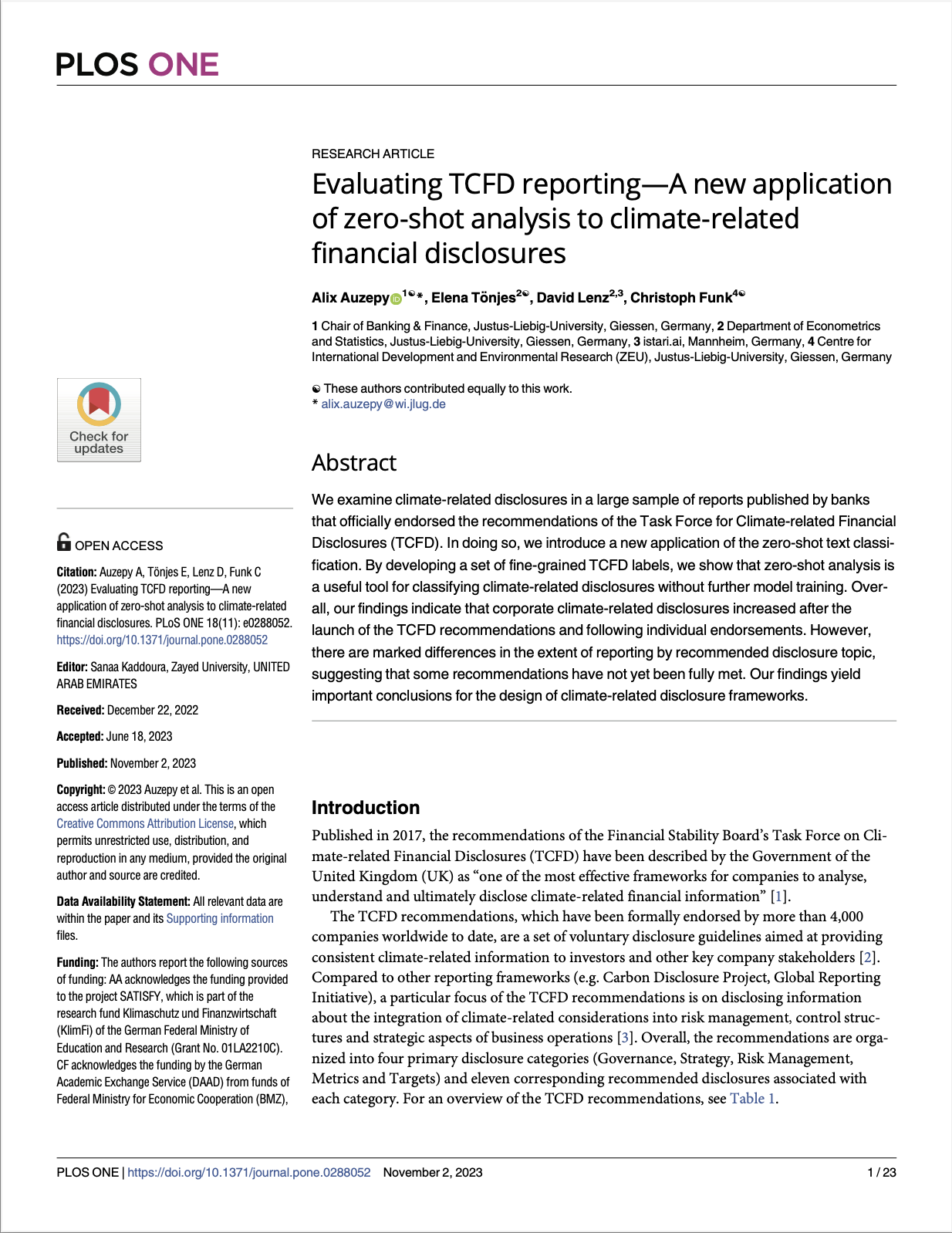
Evaluating TCFD reporting—A new application of zero-shot analysis to climate-related financial disclosures
We examine climate-related disclosures in a large sample of reports published by banks that officially endorsed the recommendations of the Task Force for Climate-related Financial Disclosures (TCFD). In doing so, we introduce a new application of the zero-shot text classification. By developing a set of fine-grained TCFD labels, we show that zero-shot analysis is a useful tool for classifying climate-related disclosures without further model training. Overall, our findings indicate that corporate climate-related disclosures increased after the launch of the TCFD recommendations and following individual endorsements. However, there are marked differences in the extent of reporting by recommended disclosure topic, suggesting that some recommendations have not yet been fully met. Our findings yield important conclusions for the design of climate-related disclosure frameworks.
- Veröffentlichungsdatum: 02.11.2023
- Autor:innen: Alix Auzepy, Elena Tönjes David Lenz & Christoph Funk
- Publikationsart: Research Article
- Link zum PDF-Dokument
SATISFY I Scenario Analysis for Net Zero: The Applicability of Climate Neutrality Studies for Transitioning Firms in the German Building Sector and Energy-intensive Industry
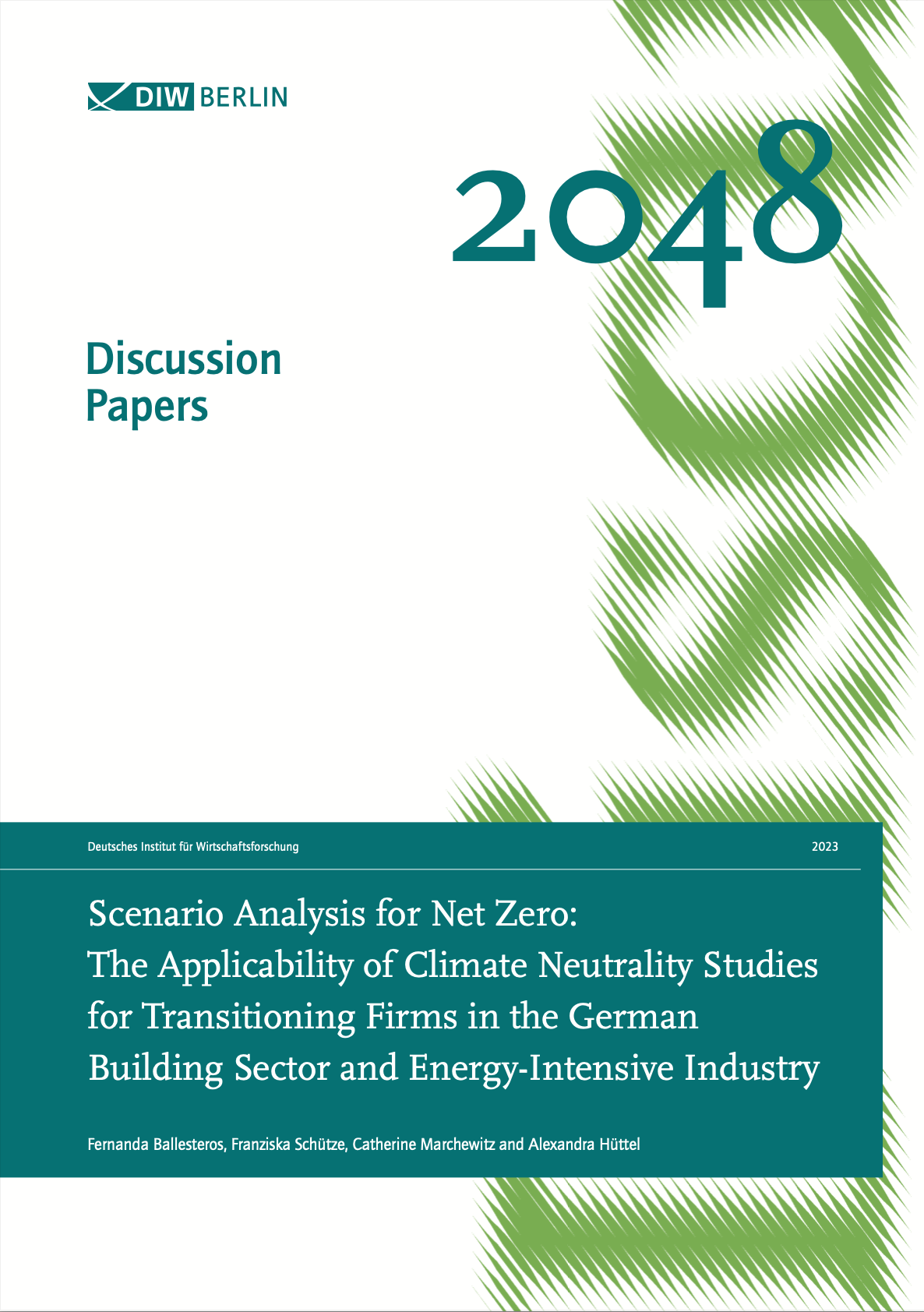
Scenario Analysis for Net Zero: The Applicability of Climate Neutrality Studies for Transitioning Firms in the German Building Sector and Energy-intensive Industry
Various stakeholders are increasingly encouraging companies from the real economy to adopt measures facilitating their transition towards carbon neutrality. In this context, companies are expected to implement forward-looking strategies and climate-related reporting practices using scenario analysis aligned with scientific evidence and credible pathways to net zero carbon emissions. This paper examines the potential of scenario analysis as element for transitioning to net zero. We review and compare eight existing economy and sector level climate neutrality studies for Germany that were published between 2019 and 2021, analysing their respective applicability as a science-based reference scenario for companies to strengthen strategy development and forward-looking reporting practices. Using the logical framework approach, we assess relevant transition indicators like technologies, energy and resource efficiency, carbon pricing, and other steering instruments for the building and energy-intensive industry sectors. These indicators serve to measure progress towards climate neutrality and could be included as a crucial component in transition plans. We find that, although modelling approaches for the studies differ, they often converge on similar results that can partially be translated to indicators at the firm level and, thereby, may serve as reference scenario for their transition planning.
- Veröffentlichungsdatum: 2023
- Autor:innen: Fernanda Ballesteros, Franziska Schütze, Catherine Marchewitz & Alexandra Hüttel
- Publikationsart: Discussion Paper
- Keywords: Climate Change, Scenarios Analysis, Decarbonization, Sustainability Reporting, Transition Plans, Sectoral Pathways
- Link zum PDF-Dokument
SuFi I Greener and cheaper: Green monetary policy in the era of inflation and high interest rates
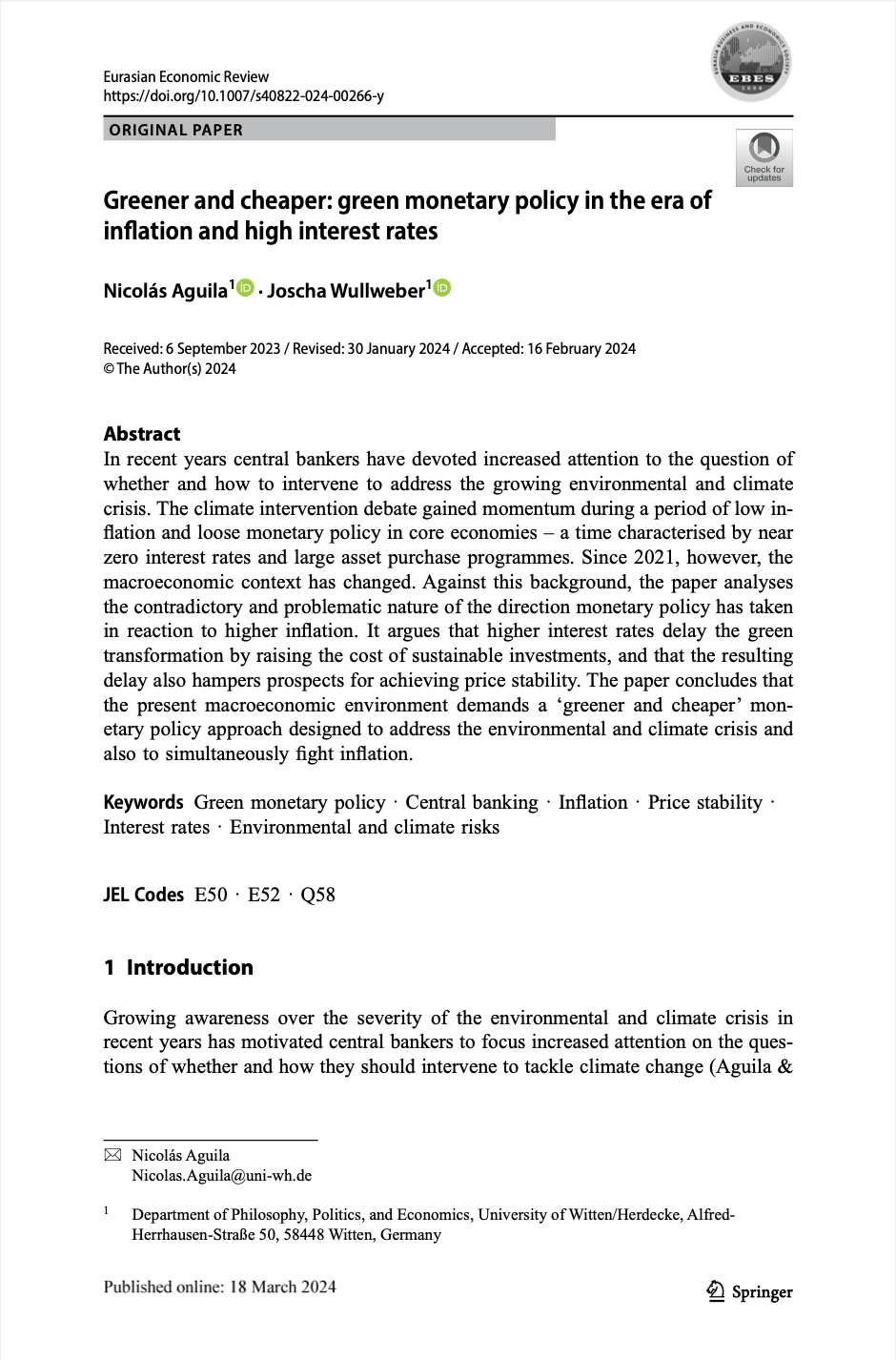
Greener and cheaper: Green monetary policy in the era of inflation and high interest rates
In recent years central bankers have devoted increased attention to the question of whether and how to intervene to address the growing environmental and climate crisis. The climate intervention debate gained momentum during a period of low inflation and loose monetary policy in core economies – a time characterised by near zero interest rates and large asset purchase programmes. Since 2021, however, the macroeconomic context has changed. Against this background, the paper analyses the contradictory and problematic nature of the direction monetary policy has taken in reaction to higher inflation. It argues that higher interest rates delay the green transformation by raising the cost of sustainable investments, and that the resulting delay also hampers prospects for achieving price stability. The paper concludes that the present macroeconomic environment demands a ‘greener and cheaper’ monetary policy approach designed to address the environmental and climate crisis and also to simultaneously fight inflation.
- Veröffentlichungsdatum: 18.03.2024
- Autor:innen: Nicolás Aguila & Joscha Wullweber
- Publikationsart: Paper
- Keywords: Green monetary policy, Central banking, Inflation, Price stability, Interest rates, Environmental and climate risks
- Link zum PDF-Dokument
SuFi I Legitimising green monetary policies: Market liberalism, layered central banking, and the ECB’s ongoing discursive shift from environmental risks to price stability
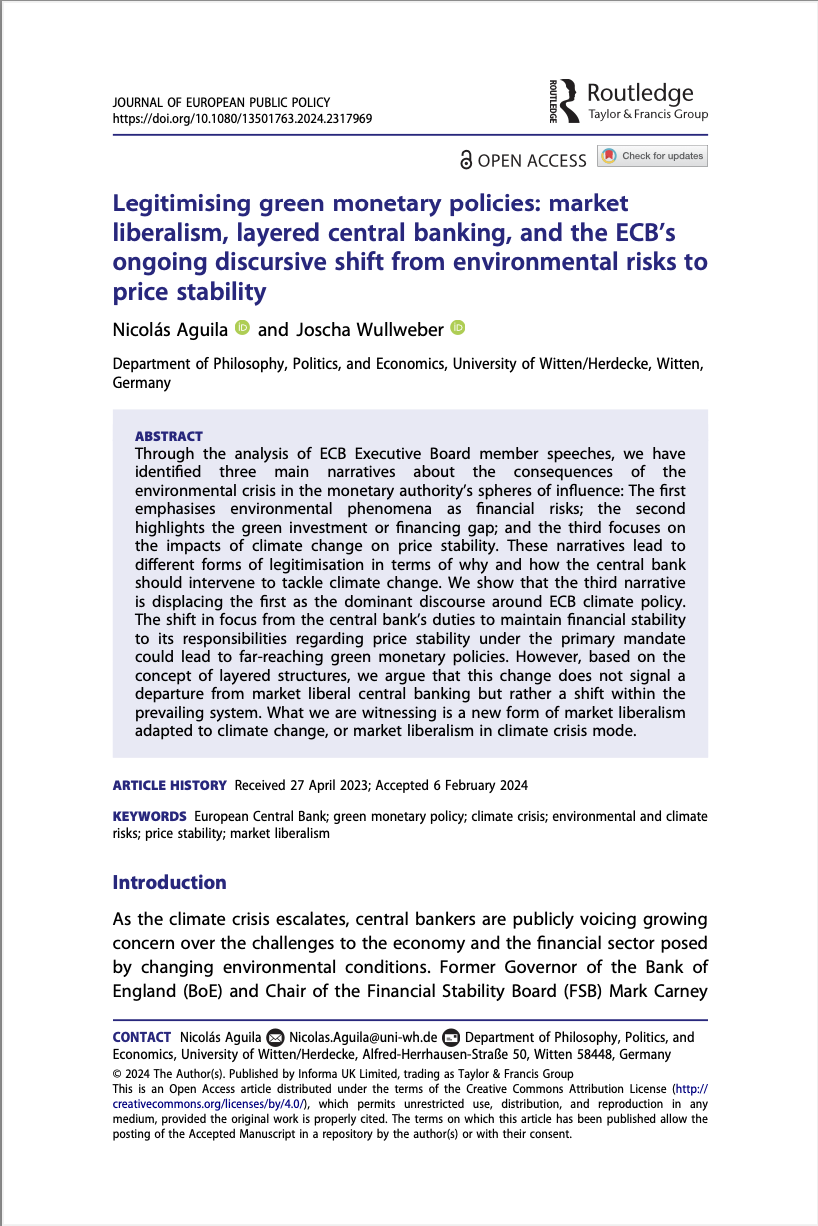
Legitimising green monetary policies: Market liberalism, layered central banking, and the ECB’s ongoing discursive shift from environmental risks to price stability
Through the analysis of ECB Executive Board member speeches, we have identified three main narratives about the consequences of the environmental crisis in the monetary authority’s spheres of influence: The first emphasises environmental phenomena as financial risks; the second highlights the green investment or financing gap; and the third focuses on the impacts of climate change on price stability. These narratives lead to different forms of legitimisation in terms of why and how the central bank should intervene to tackle climate change. We show that the third narrative is displacing the first as the dominant discourse around ECB climate policy. The shift in focus from the central bank’s duties to maintain financial stability to its responsibilities regarding price stability under the primary mandate could lead to far-reaching green monetary policies. However, based on the concept of layered structures, we argue that this change does not signal a departure from market liberal central banking but rather a shift within the prevailing system. What we are witnessing is a new form of market liberalism adapted to climate change, or market liberalism in climate crisis mode.
- Veröffentlichungsdatum: 17.02.2024
- Autor:innen: Nicolás Aguila & Joscha Wullweber
- Publikationsart: Article
- Keywords: European Central Bank; green monetary policy,
- Link zum PDF-Dokument
